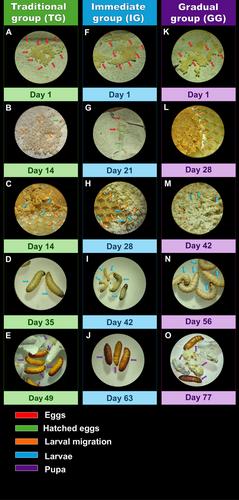Paulo Henrique Fonseca do Carmo, Patrícia Michelle Nagai de Lima, Fabiana Alves de Souza Silva, Jaqueline Lemes Ribeiro, Kevin Kavanagh, Juliana Campos Junqueira, Maíra Terra Garcia
下载PDF
{"title":"探索mellonella卵的发育策略:实验室饲养的孵化和激活方法","authors":"Paulo Henrique Fonseca do Carmo, Patrícia Michelle Nagai de Lima, Fabiana Alves de Souza Silva, Jaqueline Lemes Ribeiro, Kevin Kavanagh, Juliana Campos Junqueira, Maíra Terra Garcia","doi":"10.1002/cpz1.70153","DOIUrl":null,"url":null,"abstract":"<p><i>Galleria mellonella</i> larvae are widely used for microbiological and toxicological studies due to their reproducibility of results, low costs, and ease of handling. Despite these advantages, the maintenance of homogeneous colonies of <i>G. mellonella</i> in laboratory rearing can face many challenges. We proposed a standardized protocol for the incubation of <i>G. mellonella</i> eggs, aiming to enhance larval development and provide a consistent and accessible experimental model for microbiological research. One Basic Protocol and two Alternate Protocols were established to simulate different conditions for maintaining and activating <i>G. mellonella</i> eggs. Basic Protocol, titled “Traditional group (TG),” follows our conventional protocol for egg activation with eggs being collected and stored at 27°C throughout the culture period; Alternate Protocol 1, titled “Immediate group (IG),” where eggs are stored after collection at 16°C for 120 days before being incubated at 27°C; and Alternate Protocol 2, titled “Gradual group (GG),” where the incubation temperature is gradually reduced from 27° to 16°C at a rate of 0.5°C per day, requiring 22 days to reach the target temperature. The eggs are then held at 16°C until day 76, after which the temperature is gradually increased back to 27°C at the same rate, for a total incubation time of 120 days. As a result, temperature fluctuations significantly delayed larval development in both IG and GG groups. Notably, larvae in the IG condition exhibited altered phenotypes, including abnormal pigmentation and a reduced ability to form cocoons. In contrast, despite the developmental delay, larvae in the GG condition displayed phenotypes comparable to those in the TG group. We propose that when conventional egg activation protocol (TG) is not feasible for laboratory rearing, gradual and controlled temperature changes (GG conditions) can serve as an effective alternative to prolonged egg development, as larvae from TG and GG exhibit comparable phenotype profiles. © 2025 The Author(s). Current Protocols published by Wiley Periodicals LLC.</p><p><b>Basic Protocol</b>: Traditional group (TG)</p><p><b>Alternate Protocol 1</b>: Immediate group (IG)</p><p><b>Alternate Protocol 2</b>: Gradual group (GG)</p>","PeriodicalId":93970,"journal":{"name":"Current protocols","volume":"5 5","pages":""},"PeriodicalIF":2.2000,"publicationDate":"2025-05-24","publicationTypes":"Journal Article","fieldsOfStudy":null,"isOpenAccess":false,"openAccessPdf":"https://onlinelibrary.wiley.com/doi/epdf/10.1002/cpz1.70153","citationCount":"0","resultStr":"{\"title\":\"Exploring Strategies for the Development of Galleria mellonella Eggs: Incubation and Activation Methods in Laboratory Rearing\",\"authors\":\"Paulo Henrique Fonseca do Carmo, Patrícia Michelle Nagai de Lima, Fabiana Alves de Souza Silva, Jaqueline Lemes Ribeiro, Kevin Kavanagh, Juliana Campos Junqueira, Maíra Terra Garcia\",\"doi\":\"10.1002/cpz1.70153\",\"DOIUrl\":null,\"url\":null,\"abstract\":\"<p><i>Galleria mellonella</i> larvae are widely used for microbiological and toxicological studies due to their reproducibility of results, low costs, and ease of handling. Despite these advantages, the maintenance of homogeneous colonies of <i>G. mellonella</i> in laboratory rearing can face many challenges. We proposed a standardized protocol for the incubation of <i>G. mellonella</i> eggs, aiming to enhance larval development and provide a consistent and accessible experimental model for microbiological research. One Basic Protocol and two Alternate Protocols were established to simulate different conditions for maintaining and activating <i>G. mellonella</i> eggs. Basic Protocol, titled “Traditional group (TG),” follows our conventional protocol for egg activation with eggs being collected and stored at 27°C throughout the culture period; Alternate Protocol 1, titled “Immediate group (IG),” where eggs are stored after collection at 16°C for 120 days before being incubated at 27°C; and Alternate Protocol 2, titled “Gradual group (GG),” where the incubation temperature is gradually reduced from 27° to 16°C at a rate of 0.5°C per day, requiring 22 days to reach the target temperature. The eggs are then held at 16°C until day 76, after which the temperature is gradually increased back to 27°C at the same rate, for a total incubation time of 120 days. As a result, temperature fluctuations significantly delayed larval development in both IG and GG groups. Notably, larvae in the IG condition exhibited altered phenotypes, including abnormal pigmentation and a reduced ability to form cocoons. In contrast, despite the developmental delay, larvae in the GG condition displayed phenotypes comparable to those in the TG group. We propose that when conventional egg activation protocol (TG) is not feasible for laboratory rearing, gradual and controlled temperature changes (GG conditions) can serve as an effective alternative to prolonged egg development, as larvae from TG and GG exhibit comparable phenotype profiles. © 2025 The Author(s). Current Protocols published by Wiley Periodicals LLC.</p><p><b>Basic Protocol</b>: Traditional group (TG)</p><p><b>Alternate Protocol 1</b>: Immediate group (IG)</p><p><b>Alternate Protocol 2</b>: Gradual group (GG)</p>\",\"PeriodicalId\":93970,\"journal\":{\"name\":\"Current protocols\",\"volume\":\"5 5\",\"pages\":\"\"},\"PeriodicalIF\":2.2000,\"publicationDate\":\"2025-05-24\",\"publicationTypes\":\"Journal Article\",\"fieldsOfStudy\":null,\"isOpenAccess\":false,\"openAccessPdf\":\"https://onlinelibrary.wiley.com/doi/epdf/10.1002/cpz1.70153\",\"citationCount\":\"0\",\"resultStr\":null,\"platform\":\"Semanticscholar\",\"paperid\":null,\"PeriodicalName\":\"Current protocols\",\"FirstCategoryId\":\"1085\",\"ListUrlMain\":\"https://currentprotocols.onlinelibrary.wiley.com/doi/10.1002/cpz1.70153\",\"RegionNum\":0,\"RegionCategory\":null,\"ArticlePicture\":[],\"TitleCN\":null,\"AbstractTextCN\":null,\"PMCID\":null,\"EPubDate\":\"\",\"PubModel\":\"\",\"JCR\":\"\",\"JCRName\":\"\",\"Score\":null,\"Total\":0}","platform":"Semanticscholar","paperid":null,"PeriodicalName":"Current protocols","FirstCategoryId":"1085","ListUrlMain":"https://currentprotocols.onlinelibrary.wiley.com/doi/10.1002/cpz1.70153","RegionNum":0,"RegionCategory":null,"ArticlePicture":[],"TitleCN":null,"AbstractTextCN":null,"PMCID":null,"EPubDate":"","PubModel":"","JCR":"","JCRName":"","Score":null,"Total":0}
引用次数: 0
引用
批量引用





 求助内容:
求助内容: 应助结果提醒方式:
应助结果提醒方式:


